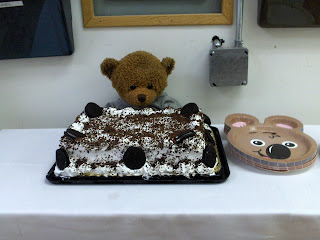 The Mets issued a press release yesterday stating that the Year of The Dodger is over. Next year, Citi Field will feature more Mets-centric imagery and colors. However, upon reading the press release, I noticed one thing was missing from the new additions. Astute Studious Metsimus readers should find it easy to surmise what it is.
The Mets issued a press release yesterday stating that the Year of The Dodger is over. Next year, Citi Field will feature more Mets-centric imagery and colors. However, upon reading the press release, I noticed one thing was missing from the new additions. Astute Studious Metsimus readers should find it easy to surmise what it is.First off, I applaud the Mets for making changes to Citi Field both inside and out. Among the new features you will find next season will be:
The VIP entrances near first base, third base and left field will be renamed after Gil Hodges, Tom Seaver and Casey Stengel, respectively.
The bridge in right field will be renamed Shea Bridge in honor of William A. Shea. I am pleased that it will not be renamed the Adam Dunn Bridge after the Washington National who claimed it as his own when he took one small poke for Dunn, one giant blast for everyone else. (In laybear's terms, he became the first player to reach the bridge with a home run.)
 The stairwells will be painted in the traditional Mets colors (blue and orange, NOT black) instead of the drab gray that mirrored the feelings of the fans as they exited the stadium after each loss.
The stairwells will be painted in the traditional Mets colors (blue and orange, NOT black) instead of the drab gray that mirrored the feelings of the fans as they exited the stadium after each loss.Outside Citi Field, full color banners will be visible on the Mets Plaza outside the Jackie Robinson Rotunda and the flowers planted outside the Plaza will be blue and orange.
The main addition to Citi Field in 2010 will be the Mets Hall of Fame and Museum, which will be adjacent to the Jackie Robinson Rotunda. A new Mets Hall of Fame committee, including long-time radio and TV broadcasters Gary Cohen and Howie Rose, will be formed to evaluate Mets Hall of Fame members. No player has been inducted since the late Tommie Agee in 2002.
These new additions will make Citi Field appear more like a Mets stadium and not Dodger Stadium East. That's all fine and dandy, but they seem to have forgotten one thing that this bear blogger just had to get up on his soapbox for.
WHERE IN THE NAME OF JULIO FRANCO IS CAKE SHACK?
 Little Jeffy Wilpon and Omar Minaya had no problem getting cake into the tummy of Julio Franco. Why can't the fans have our cake and eat it, too?
Little Jeffy Wilpon and Omar Minaya had no problem getting cake into the tummy of Julio Franco. Why can't the fans have our cake and eat it, too?We appreciate all you did in 2009 to make Citi Field an eater's paradise. The chicken nachos and cannolis were a welcome addition to an otherwise bland food selection at Shea Stadium. The eclectic selections would make any caterer blue and orange with envy.
If the team is going to cater to all its fans, then one more thing needs to be added. Since the team is renaming many things at Citi Field in time for the 2010 season, I'd like to offer my suggestion.
 Ever since I found out about the Shake Shack that debuted at Citi Field this season, I've wanted the team to open up a Cake Shack, which would specialize in my fav'rit food. However, since I want to be known for my blogging ability and not for my penchant for wolfing down cake, I'd like to propose my idea for a new food stand, Citi Confectioneries.
Ever since I found out about the Shake Shack that debuted at Citi Field this season, I've wanted the team to open up a Cake Shack, which would specialize in my fav'rit food. However, since I want to be known for my blogging ability and not for my penchant for wolfing down cake, I'd like to propose my idea for a new food stand, Citi Confectioneries.Citi Confectioneries would specialize in candies, cookies and pastries. The cannolis can get special treatment there. They can also sell rainbow cookies, similar to the ones in the picture below. However, instead of the colors in the photo, they can be blue and orange surrounded by chocolatey goodness.
 Holy cannolis, Batman! How hard would it be to add a Cake Shack and a Citi Confectioneries? If you can't do anything to improve the team this offseason, at least keep my sweet tooth happy. Then the fans who came to Citi Field dressed as empty seats in September can feast on something new while opposing teams feast on the Mets.
Holy cannolis, Batman! How hard would it be to add a Cake Shack and a Citi Confectioneries? If you can't do anything to improve the team this offseason, at least keep my sweet tooth happy. Then the fans who came to Citi Field dressed as empty seats in September can feast on something new while opposing teams feast on the Mets.I don't expect any of this to happen at Citi Field next season, but perhaps if our readers could start a petition, it could become a reality eventually. I'd make my voice heard, but it would be rude to talk with my mouth full.






























